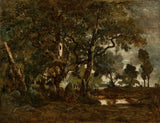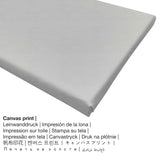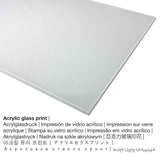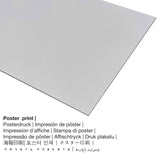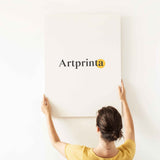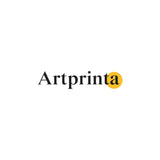Théodore Rousseau, 1855 - ọhịa Fontainebleau, ụyọkọ osisi toro ogologo - mbipụta nka mara mma.
Ụtụ gụnyere. Mbupu gbakọrọ na ndenye ọpụpụ.
Nkọwa ihe osise site na ihe ngosi nka (© Nwebiisinka - nke J. Paul Getty Museum - www.getty.edu)
A live oak dominates this late afternoon landscape. Diffuse light from the overcast sky reflects off the pond and up into the branches. The boulders, grass and broken branches in the foreground are barely suggested and the single figure making his way around the pond followed by a herd of cows is thinly sketched.
Landscape painter Théodore Rousseau lived in the nearby village of Barbizon, returning often to the forest of Fontainebleau to paint. When commercial exploitation threatened the forest, Rousseau wrote to the Duke of Morny, an influential politician close to Napoleon III, to urge the preservation of the forest.
During the summer Rousseau made use of a special easel and lean-to to facilitate painting outdoors. This painting belongs to a category known as dessin-peinture in which the artist notes the composition on site in chalk and thin layers of paint, and then returns to the studio to enhance particular elements and unite the composition.
Ozi ndabere ọrụ nka
| Aha nka: | "Forest of Fontainebleau, Cluster of Tall Trees" |
| Nhazi nka nka: | sere |
| Otu izugbe: | nkà nke oge a |
| Nhazi oge: | 19th narị afọ |
| Emepụtara na: | 1855 |
| Ogologo afọ nka nka: | ihe karịrị 160 afọ |
| Usoro nka izizi: | mmanụ na kwaaji |
| Nha izizi (ọrụ nka): | 90,8 x 116,8 cm |
| Egosiputara na: | Ụlọ ihe ngosi nka nke J. Paul Getty |
| Ebe ebe ngosi nka: | Los Angeles, California, Njikota Obodo Amerika |
| Ebe nrụọrụ weebụ ihe ngosi nka: | Ụlọ ihe ngosi nka nke J. Paul Getty |
| Ụdị nka nka: | ngalaba ọha |
| Site n'aka: | Ụlọ ihe ngosi nka nke J. Paul Getty |
Ozi izugbe gbasara onye na-ese ihe
| Ihe nkiri: | Théodore Rousseau |
| okike nke onye nka: | nwoke |
| Nationality: | French |
| Ọrụ: | onye na-ese ihe |
| Country: | France |
| Nhazi nke onye nka: | omenkà nke oge a |
| styles: | Ihe ngosi |
| Nwụrụ anwụ: | 55 afọ |
| Afọ amụrụ: | 1812 |
| Ebe omuma: | Paris, France |
| Afọ nwụrụ: | 1867 |
| Ebe ọnwụ: | Barbizon, France |
Banyere edemede a
| Nkewa ngwaahịa: | ọmarịcha nka |
| Usoro mmeputakwa: | mmeputakwa n'ụdị dijitalụ |
| Produzọ mmepụta: | Mbipụta UV ozugbo (mbipụta dijitalụ) |
| Production: | emere na Germany |
| Ụdị ngwaahịa: | na mmepụta ihe |
| Eji ngwaahịa a chọrọ: | nchịkọta nka (mmeputakwa), ụlọ mmepụta nka nka |
| Nhazi: | nhazi odida obodo |
| Oke akụkụ: | ogologo: obosara 4:3 |
| Pụtara nha onyonyo a: | ogologo bụ 33% ogologo karịa obosara |
| Akwa ngwaahịa dị: | Mpempe akwụkwọ, akwụkwọ mmado (akwụkwọ kwaaji), mbipụta ọla (aluminium dibond), mbipụta iko acrylic (nwere ezigbo mkpuchi iko) |
| Ọdịiche dị n'okirikiri akwa akwa akwa (akwa akwa): | 40x30cm - 16x12", 80x60cm - 31x24", 120x90cm - 47x35", 160x120cm - 63x47" |
| Mpempe iko acrylic (nwere ezigbo mkpuchi iko) nha dị iche iche: | 40x30cm - 16x12", 80x60cm - 31x24", 120x90cm - 47x35" |
| Nhọrọ nke mbipụta akwụkwọ mmado (akwụkwọ kwaaji): | 40x30cm - 16x12", 80x60cm - 31x24", 120x90cm - 47x35" |
| Nhọrọ ebipụta aluminom: | 40x30cm - 16x12", 80x60cm - 31x24", 120x90cm - 47x35" |
| Igwe onyonyo: | enweghị etiti |
Họrọ ihe ngwaahịa ị ga-atụkwasị na mgbidi gị
Anyị na-enye ihe dị iche iche dị iche iche na nha maka ngwaahịa ọ bụla. Anyị na-ahapụ gị ka ịhọrọ nha na akụrụngwa ọkacha mmasị gị n'etiti nhọrọ nhazi ngwaahịa ndị a:
- Mbipụta kanvas: A printed canvas, which should not be confused with a painting on a canvas, is a digital image applied on a canvas material. A canvas creates the exclusive effect of three dimensionality. Canvas prints are relatively low in weight, meaning that it is easy and straightforward to hang up your Canvas print without additional wall-mounts. Because of thata canvas print is suitable for any kind of wall.
- Mbipụta akwụkwọ mmado (ihe kwaaji): The poster print is a printed sheet of flat canvas paper with a fine texture on the surface. A poster print is best suited for placing the art replica with the help of a custom frame. Please note, that depending on the size of the canvas poster print we add a white margin of something between 2-6cm around the painting, which facilitates the framing with your custom frame.
- Mbipụta iko acrylic (nke nwere ezigbo mkpuchi iko): The acrylic glass print, often denoted as a an art print on plexiglass, changes your favorite original work of art into lovely décor. Your own copy of the artwork is custom-made with the help of modern UV printing machines. Our acrylic glass protects your custom art print against light and heat for many decades.
- Mbipụta nke aluminom: An Aluminium Dibond print is a print material with an impressive depth, creating a fashionable look with a non-reflective surface. The bright parts of the artwork shimmer with a silk gloss but without the glare.
About the artwork created by Théodore Rousseau
Forest of Fontainebleau, Cluster of Tall Trees was painted by Théodore Rousseau in 1855. The version of the work of art measures the size of 90,8 x 116,8 cm and was produced on the medium mmanụ na kwaaji. N'oge a, ọrụ nka a nwere ike ile anya na nchịkọta dijitalụ nke Ụlọ ihe ngosi nka nke J. Paul Getty. With courtesy of: The J. Paul Getty Museum (public domain).Additionally, the artpiece has the following creditline: . The alignment of the digital reproduction is in odida obodo usoro ma nwee oke nke 4: 3, nke pụtara na ogologo bụ 33% ogologo karịa obosara. The painter Théodore Rousseau was an artist from France, whose art style can be attributed mainly to Realism. The Realist painter was born in 1812 na Paris, France ma nwụọ mgbe ọ dị afọ 55 na 1867.
Ederede iwu dị mkpa: We try everythig possible to depict the art products as accurate as possible and to display them visually in our shop. Although, the colors of the print materials, as well as the imprint might differ somehwat from the presentation on the monitor. Depending on your settings of your screen and the nature of the surface, color pigments may not be printed as exactly as the digital version depicted here. Since all our art reproductions are printed and processed by hand, there might also be slight variations in the motif's size and exact position.
Enwere ikike nwebiisinka ©, Artprinta (www.artprinta.com)

